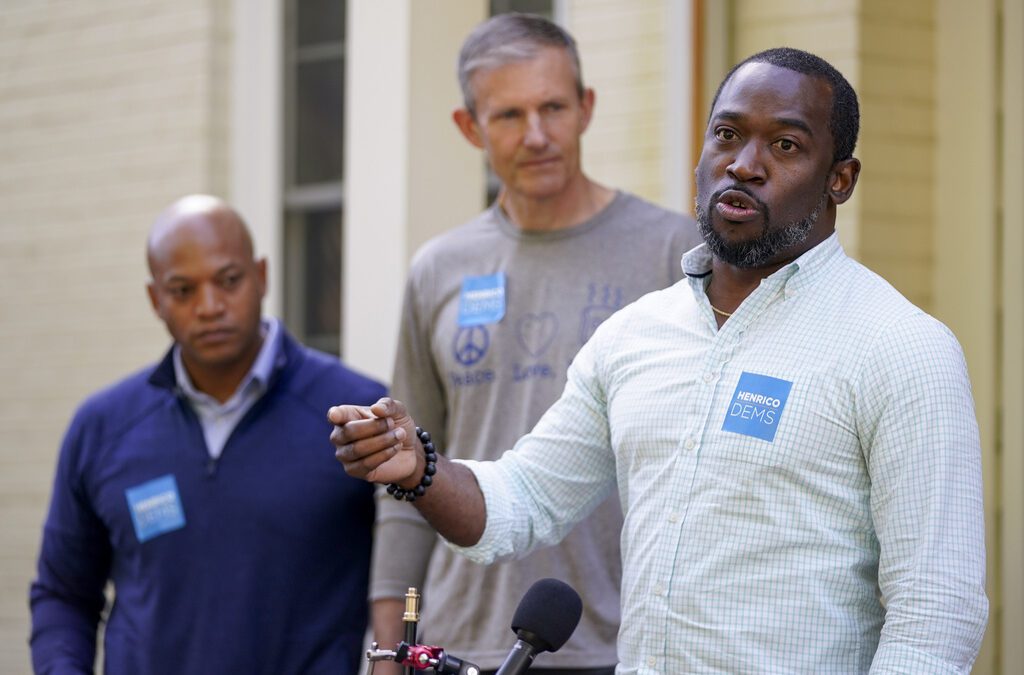
A look at the freight station that stood where Orion Anderson was killed in Loudoun County. Photo courtesy of NOVA Parks.
A Virginia county commemorates Juneteenth in its own significant way.
LEESBURG – His own family didn’t know. That’s partly why Pastor Michelle Thomas, president of the Loudoun NAACP, tells the story of Orion Anderson as part of the Juneteenth event.
A white supremacist mob killed the 14-year-old Black child in 1889 in Leesburg.
“[They] broke him out of the Loudoun County Jail and he was drug down a particular route, and then hung and shot at the W&OD Trail– the [location of the former] train depot [of] downtown Leesburg,” Thomas said.
Why? He placed a bag over his head and tried prank his neighbor, a teenage white girl named May Leith. It was Oct. 30, 1889, the day before Halloween. He was arrested and taken to jail, where a mob of more than two dozen grabbed him later that night.
Newspaper reports at the time falsely claimed Anderson was upwards of 20 years old. The reports also falsely changed a childhood prank into something sinister – they insinuated that Anderson raped Leith.
Orion became one of three young Black lynching victims in Loudoun County between 1880 and 1902.
On Saturday, his story lives on as part of Loudoun’s Juneteenth commemoration. The event features a march along the same path Orion took to the train depot, followed by a ceremony.
“We elevate the Juneteenth celebration in the way that we recommit ourselves with our community partners to the ideals of freedom as it relates to economic freedom, as it relates to land ownership, as it relates to community partnership,” Thomas said.
Celebrating A Change During Juneteenth
President Abraham Lincoln issued the Emancipation Proclamation on Sept. 22, 1862. However, it took two and a half more years for that order to be enforced across the country. As Union soldiers advanced through the South, they enforced and in many cases informed people about the change. Such was the case on June 19, 1865, the date we recognize now as Juneteenth.
Texas hadn’t seen major fighting during the Civil War. As a result, there weren’t many Union soldiers on hand to enforce the new order. After Lincoln’s proclamation, many slaveholders moved there and pretended like nothing changed. That ended in 1865. On June 19 of that year, Union Army general Gordon Granger arrived to take control of Texas.
He landed in Galveston and read General Order No. 3, making it clear all enslaved people were now free.
“The people of Texas are informed that in accordance with a Proclamation from the Executive of the United States, all slaves are free,” the order states. “This involves an absolute equality of rights and rights of property between former masters and slaves, and the connection therefore existing between them becomes that between employer and hired laborer.”
Throughout the years, people have celebrated this announcement in a variety of ways and locations. Photos dating back as early as 1905 show Juneteenth celebrations taking place in Richmond.
From sanctified ceremonies to community-wide celebrations with music, dancing and fellowship, everything from economics to geography to personal preferences plays a role in the type of commemorative event a community might host.
A Meaningful March
But back to Loudoun County for a minute. If Anderson was only 14 in 1889, that means he was born in 1875, a full decade after Juneteenth. That also means that Anderson was never enslaved, as his birth date fell 12 years after the Emancipation Proclamation went into effect.
Why would the area memorialize him on a day centered around the freedom that occurred in Texas 10 years before?
Thomas says when people march together, there’s a measure of solidarity and unity – and those principals tie into Juneteenth.
“Having solidarity and unity around the experience of freedom – also having solidarity and unity around, you know, the horrors of the African American experience of being enslaved in America – those things are very, very important,” Thomas said. “And then solidarity around our path forward together is very important.”
The Black experience lives on through the march and later festivities.
“We’re talking about emancipation. We’re talking about the first time people are able to realize the American dream,” Thomas said. “For the very first time, that they are, you know, met with a measure of full citizenship, being able to own land, being able to experience life, liberty and the pursuit of happiness.”
Following Juneteenth, Blacks in America still faced racial discrimination. From Jim Crow laws to the Civil Rights movement and beyond, Thomas recalled those that fought against inequities. Given all that occurred since June 19, 1865, emotions relating to the day remain in generations, even 156 years later.
“So, yeah, it’s emotional because there are people at every spectrum of this freedom experience,” Thomas said. “So sure, we may all be physically free, but there’s a great part of this – the African American experience – that is, still to be free mentally and financially and emotionally from slavery.”
More to Do
Like Loudoun County, some Juneteenth commemorative events across the state also add in elements pertaining to the Black experience in America.
For example, as part of its Juneteenth celebration, Pocahontas State Park in Chesterfield will host a five-mile hike on Saturday in a once-segregated area of the park. In Norfolk on the same day, a group will walk alongside the Elizabeth River, hearing stories of the city’s waterfront and its ties to slavery. At Freedom Park in Williamsburg, a former free Black settlement, visitors will hear stories about the lives of Black Americans.
The problem, said Dr. Amy Tillerson-Brown, is the same we see with other holidays. Some celebrants still don’t understand the importance of the date.
“There are some communities that think Juneteenth is important just because it’s this day of jubilee and they don’t think about what brought them to that,” said Tillersoon-Brown, a history professor at Mary Baldwin University. “I still think it probably needs more interrogation and revision.”
Ultimately, there’s still more work to do.
“What we’re hoping for Juneteethn [is] that as we celebrate it annually, as we do our annual march, as we have our annual celebrations and ceremonies that Juneteenth, the time where the last enslaved people of Texas were freed, we don’t want that to leave our memory,” Thomas said. “We must understand that, you know, not everybody is free at the same time. And freedom is something that must be maintained. Freedom is something that is not a one-and-done. It is a continual commitment to be free in every area of our lives.”
Amie Knowles reports for Dogwood. You can reach her at [email protected]
JOIN THE CONVERSATION: Sign Up For Dogwood’s Newsletter
Politics

Biden administration bans noncompete clauses for workers
The Federal Trade Commission (FTC) voted on Tuesday to ban noncompete agreements—those pesky clauses that employers often force their workers to...

Democratic shakeup in Virginia primaries for governor, lieutenant governor
Richmond Mayor Levar Stoney quit his bid for governor and jumped into the race to be the Democratic nominee for lieutenant governor. The race for...
Local News

The zodiac signs of 12 iconic women offer insight into their historic accomplishments
Zodiac signs can tell you a lot about someone’s personality. Whether they’re an earth, water, air, or fire sign, these 12 categories (which are...

Virginia verses: Celebrating 5 poetic icons for National Poetry Month
There’s no shortage of great writers when it comes to our commonwealth. From the haunting verses of Edgar Allan Poe, who found solace in Richmond's...





